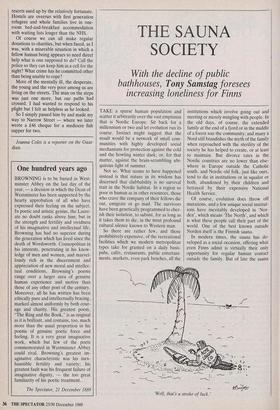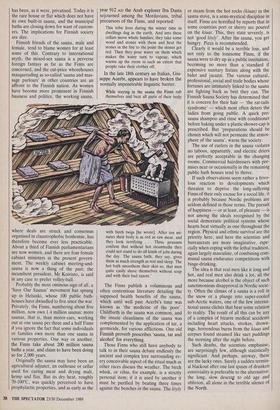THE SAUNA SOCIETY
With the decline of public increasing loneliness for Finns
TAKE a sparse human population and scatter it arbitrarily over the vast emptiness that is Nordic Europe. Sit back for a millennium or two and let evolution run its course. Instinct might suggest that the result would be a network of small com- munities with highly developed social mechanisms for protection against the cold and the howling winter dark; or, for that matter, against the brain-scrambling ubi- quitous light of summer.
Not so. What seems to have happened instead is that nature in its wisdom has discerned that clubbability is no survival trait in the Nordic habitat. In a region so poor in human as in other resources, those who crave the company of their fellows die out, emigrate or go mad. The survivors have been genetically programmed to cher- ish their isolation, to subsist, for as long as it takes them to die, in the most profound cultural silence known to Western man.
So there are rather few, and those prohibitively expensive, of the recreational facilities which we modern metropolitan types take for granted on a daily basis: pubs, cafes, restaurants, public entertain- ments, markets, even park benches, all the
institutions which involve going out and meeting or merely mingling with people. In the old days, of course, the extended family at the end of a fjord or in the middle of a forest was the community; and many a Nord still brandishes the myth of the family when reproached with the sterility of the society he has helped to create, or at least to maintain. But divorce rates in the Nordic countries are no lower than else- where in Europe outside the Catholic south, and Nordic old folk, just like ours, tend to die in institutions or in squalor or both, abandoned by their children and betrayed by their expensive National Health Service.
Of course, evolution does throw off mutations, and a few unique social institut- ions have inevitably developed in 'Nor- den', which means 'The North', and which is what these people call their part of the world. One of the best known outside Norden itself is the Finnish sauna.
In modern times, the sauna has de- veloped as a social occasion, offering what even Finns admit is virtually their only opportunity for regular human contact outside the family. But of late the sauna 'Well, that's a stroke of luck.' has been, as it were, privatised. Today it is the rare house or flat which does not have its own built-in sauna, and the municipal baths are closing down for want of custom- ers. The implications for Finnish society are dire.
Finnish friends of the sauna, male and female, tend to blame women for at least some of this. Contrary to international myth, the mixed-sex sauna is a perverse foreign fantasy as far as the Finns are concerned, and the cut-price whorehouses masquerading as so-called 'sauna and mas- sage parlours' in other countries are an affront to the Finnish nation. As women have become more prominent in Finnish business and politics, the working sauna,
where deals are struck and consensus organised in claustrophobic bonhomie, has therefore become ever less practicable. About a third of Finnish parliamentarians are now women, and there are four female cabinet ministers in the present govern- ment. The weekly cabinet meeting-and- sauna is now a thing of the past; the incumbent president, Mr Koivisto, is said in any case to prefer volley-ball.
Probably the most ominous sign of all, a 'Save Our Saunas' movement has sprung up in Helsinki, whose 100 public bath- houses have dwindled to five since the war. Privately, the Finns, numbering about five million, now own 1.4 million saunas: more saunas, that is, than motor-cars, working out at one sauna per three and a half Finns if you ignore the fact that some individuals or families own more than one sauna in various properties. One way or another, the Finns take about 200 million sauna baths a year, and claim to have been doing so for 2,000 years.
Originally the sauna may have been an agricultural adjunct, an outhouse or cellar used for curing meat and drying malt, hemp and flax. But its dry heat, roughly 70-100°C, was quickly perceived to have prophylactic properties, and as early as the
year 912 AD the Arab explorer Ibn Dasta. sojourned among the Mordavians, tribal precursors of the Finns, and reported:
This tribe lives during the winter time in dwellings dug in the earth. And into these cellars move whole families; they take some wood and stones with them and heat the stones in the fire to the point the stones get red. Then they pour water on them which makes the water turn to vapour, which warms up the room to such an extent that people take their clothes off.
In the late 18th century an Italian, Giu- seppe Acerbi, appears to have broken the normally impenetrable linguistic barrier.
While staying in the sauna the Finns rub themselves and heat all parts of their body with birch twigs [he wrote]. After ten mi- nutes their body is as red as raw meat, and they look terrifying . . Those peasants confirm that without hot steambaths they could not stand to do all kinds of jobs during the day. The sauna bath, they say, gives them as much strength as rest and sleep. The hot bath smoothens their skin so, that men quite easily shave themselves without soap and with their bad razors.'
The Finns publish a voluminous and often contentious literature detailing the supposed health benefits of the sauna, which until well past Acerbi's time was known as 'the medicine of the poor'. Childbirth in the sauna was common, and the innate cleanliness of the sauna was complemented by the application of tar, a germicide, for various afflictions. One old Finnish proverb prescribes 'sauna, tar and alcohol' for everything.
Those Finns who still have anybody to talk to in their sauna debate endlessly the ancient and complex lore surrounding ev- ery conceivable aspect of the ritual much as other races discuss the weather. The birch whisk, or vihta, for example, is a strictly personal item; if it is used by another it must be purified by beating three times against the benches in the sauna. The loyly or steam from the hot rocks (kivas) in the sauna stove, is a semi-mystical discipline in itself. Finns are horrified by reports that in some countries port or sherry are poured on the kivas. This, they state severely, is not 'good loyly'. After the sauna, you get hungry. Pizza is recommended.
Clearly it would be a terrible loss, and not only to the lonesome Finns, if the sauna were to dry up as a public institution, becoming no more than a standard if expensive sanitary fixture along with the bidet and jacuzzi. The various cultural, professional, social and trade bodies whose fortunes are intimately linked to the sauna are fighting back as best they can. The Finnish Sauna Society has determined that it is concern for their hair — 'the rat-tails syndrome' — which most often deters the ladies from going public. A quick pre- sauna shampoo and rinse with conditioner before baking under a plastic shower-cap is prescribed. But 'preparations should be chosen which will not permeate the atmos- phere of the sauna', warns the society.
The use of curlers in the sauna violates no taboos, apparently, and electric driers are perfectly acceptable in the changing rooms. Commercial hairdressers with pre- mises near or occasionally in the remaining public bath houses tend to thrive.
If such observations seem rather a frivo- lous reaction to developments which threaten to deprive the long-suffering Finns of their only excuse for a social life, it is probably because Nordic problems are seldom defined in those terms. The pursuit of happiness — or at least, of pleasure — is not among the ideals recognised by the social democratic political systems whose hearts beat virtually as one throughout the region. Physical and ethnic survival are the priority here, and here the scientists and bureaucrats are more imaginative, espe- cially when coping with the lethal tradition, again largely masculine, of combining com- munal sauna endurance competitions with binge-drinking.
The idea is that real men like it long and hot, and real men also drink a lot, all the more because alcohol is the object of such sanctimonious disapproval in Nordic socie- ty. Often the climax of a sauna is a roll in the snow or a plunge into super-cooled sub-Arctic waters, one of the few interna- tional sauna clichés that bear some relation to reality. The result of all this can be any of a complex of bizarre medical accidents including heart attacks, strokes, drown- ings, horrendous burns from the kivas and corpses found steamed like suet puddings the morning after the night before.
Such deaths, the scientists emphasise, are surprisingly few, although statistically significant. And perhaps, anyway, these are the lucky ones. Surely a sudden termin- al blackout after one last spasm of drunken conviviality is preferable to the alternative: the long, slow desceaj to old age and oblivion, all alone in the terrible silence of the North.











































































































 Previous page
Previous page